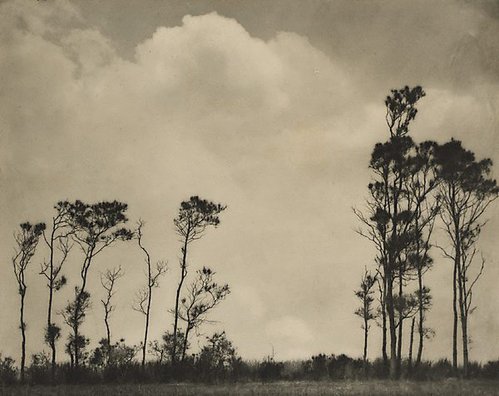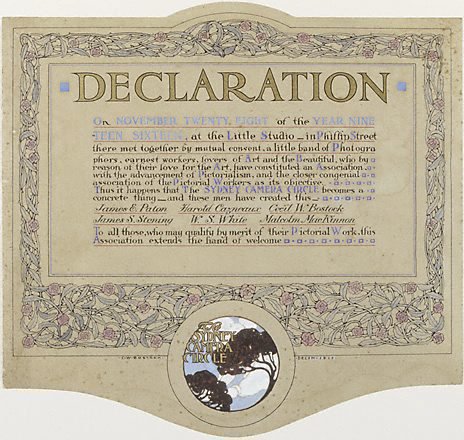-
Details
- Date
- 1918
- Media category
- Photograph
- Materials used
- gelatin silver photograph
- Dimensions
- 13.4 x 20.6 cm image/sheet; 23.6 x 29.5 cm board
- Signature & date
Signed l.r. board, pencil "Cecil W Bostock". Not dated.
- Credit
- Gift of Mr J. Hoey 1977
- Location
- Not on display
- Accession number
- 164.1977
- Copyright
- Artist information
-
Cecil Bostock
Works in the collection
- Share
-
-
About
‘Simplicity is the keynote: it does not follow that a good subject must be intricate in its composition. Carefully note the arrangement of the subject matter in pictures by our great artists, perhaps none better than Corot, whose pictures are exceptionally simple in the composition.’ Cecil Bostock 1921 1
Cecil Westmoreland Bostock was born in England and arrived in Australia in 1888.2 He was apprenticed for three years as an electrical fitter before pursuing a career as photographer and illustrator at the turn of the century. He was a founding member of the Sydney Camera Circle in 1916 and early meetings of the circle were held at his city studio. In 1917, the year he enlisted in the Australian Imperial Force, he published a portfolio of ten of his photographs in a limited edition of 25 copies. After the war he worked as a professional photographer for a number of studios in Sydney. In 1922 he held a survey exhibition of his work at the Kodak Salon. He was supportive of new developments in photography and with Max Dupain, who had been his apprentice, was a founding member of the Contemporary Camera Groupe in 1938.
Bostock served as a gunner during the First World War, returning to Australia with fellow photographer Alfred Chambers. In London, before returning home, he held an exhibition of war watercolours. ‘Day breaks-cold-shrieking-bloody’, however, seems to be his only photograph from the war. Soldier snapshots from the First World War were not uncommon; they were usually taken on a Box Brownie and bound into memorial albums, following a conventional narrative structure. Bostock’s evocative image stands clearly apart from these, as well as from the more formal and staged work by official war photographer Frank Hurley. Here the soldiers at their guns are barely discernible and the photographer has allowed what was generally considered to be a technical imperfection – halation or the prominent halo of light particles around the gun – to remain for the sake of a dramatic image. This light patch is ambivalent; it might be the breaking dawn or smoke from a recently discharged gun. This photograph was exhibited at the Photographic Salon in London in 1919. Australian critic Alek Sass thought it ‘a picture and a photograph beyond criticism … Bostock’s emotional vision rises to its highest in this picture’.3
1. Bostock C 1921, ‘Australian landscape and some notes on composition’, ‘Australasian Photo-Review’, 15 Jan p 15
2. On his 1917 enrolment form for the army, Bostock declared his age as 29 years and two months, suggesting he was born in May 1888. However all other documentation points to his birth in 1884
3. Sass A 1921, ‘(Bostock exhibition)’, ‘Australasian Photo-Review,’ 15 Dec p 618© Art Gallery of New South Wales Photography Collection Handbook, 2007
-
Exhibition history
Shown in 3 exhibitions
Australian Pictorial Photography, S.H. Ervin Gallery, The Rocks, 12 Jun 1979–08 Jul 1979
Australian Pictorial Photography, The Victorian College of the Arts Gallery, South Bank, 08 Aug 1979–31 Aug 1979
Australian Pictorial Photography, Art Gallery of South Australia, Adelaide, 01 Dec 1979–30 Jan 1980
Modernism/Japonism in photography 1920s-1940s: Ishida Kiichiro and the Sydney Camera Circle, Shôto Museum of Art, Tokyo, 23 Jul 2002–08 Sep 2002
Modernism/Japonism in photography 1920s-1940s: Ishida Kiichiro and the Sydney Camera Circle, The Akita Museum of Modern Art, Japan, 25 Apr 2003–01 Jun 2003
Follow the Flag: Australian artists at war 1914-1945, Ian Potter Centre: NGV Australia, Melbourne, 24 Apr 2015–16 Aug 2015
-
Bibliography
Referenced in 4 publications
-
Melissa Miles, The Language of Light and Dark, 'Building a Sunshine School: Pictorialism and the Landscape', pg. 27-76, Australia, 2015, 46, 47 (illus.). fig. 1.14
-
Steven Miller, Photography: Art Gallery of New South Wales Collection, 'Australian pictorialism', pg.71-91, Sydney, 2007, 84 (illus.).
-
Yuri Mitsuda, Modernism/Japonism in photography 1920s-1940s: Kiichiro Ishida and Sydney Camera Circle, 2002, 82 (illus.). cat.no. S2
-
Gael Newton, Australian Pictorial Photography, Melbourne, 1979, 16. cat.no. 4
-




